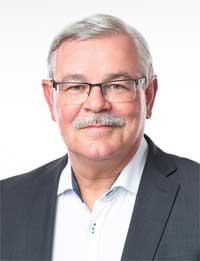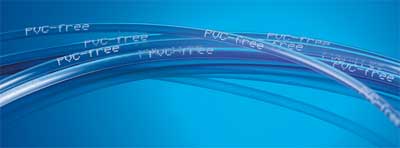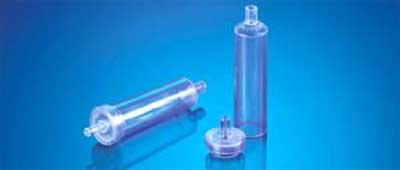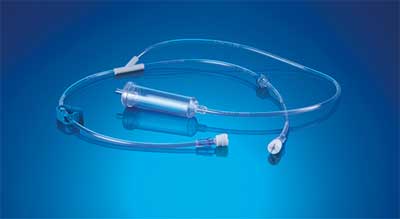|
PVC-Free Plastic
Solutions for the Medical and Pharmaceutical Industry
|

Dr. Ralf Ziembinski
Head of the Tubing Business Unit
RAUMEDIC |
Dr. Ralf Ziembinski is Head of the
Tubing Business Unit at RAUMEDIC. With a doctorate in
chemistry, he specialized in the research of inorganic
polymers as far back as his post-doc studies at the
University of Toronto, before bringing his know-how to
RAUMEDIC beginning in 2004.
Medical device manufacturers look
closely at materials intended for use before starting
the development period. In the plastics segment,
polyvinyl chloride, or PCV, has been the choice for
many medical applications. But today, there is a
growing focus on other materials; the market is
demanding alternatives. In our interview, Dr. Ralf
Ziembinski discusses the possibilities. |
Q: PVC was
indispensable for years and is still widely used today.
But the material is increasingly the subject of public
criticism. Is it warranted?
This is where we have
to make a strict distinction. In the field of medical
technology, the criticism is largely aimed at the
plasticizers in the material. It has been proven that DEHP
or DOP exhibit reprotoxic characteristics and can be
comparatively easily dissolved out of the material. We
have used DEHP-free plasticizers, such as noDOP, for years
to rule out this risk. The probability of migration is 100
times less with these substances.
The EU Commission is
also taking action: The present exemption that permits the
now discredited phthalate for blood bags and transfusion
tubes will only be valid for a further three years after
Appendix XIV of the REACH regulation comes into effect.

Q: Are there still
any arguments in favor of PVC?
There certainly are for
medical-grade plastic disposable products, because the
material is cost-effective, it is suitable for secondary
processing and it has been proven for decades. While
earlier materials such as glass and rubber were used in
medicine, PVC has helped make healthcare better and safer.
As long as it is DEHP-free medical grade quality, the
material is also highly tissue and blood compatible.
In the clinical
setting, it is also extremely important that PVC parts and
components can be easily sterilized before use. Because no
one wants to risk an infection caused by germs.
Q: Will PVC
disappear from medical and pharmaceutical applications?
This is a matter of
cost more than anything. If alternative materials with a
similar price point and comparable properties break
through in the market, that is certainly possible.
Otherwise the healthcare system would be heavily impacted.
We therefore believe
that PVC will continue to have a certain right to exist in
the medical and pharmaceutical industry. Its qualities
such as biocompatibility and sterilization capability as
well as technical factors such as flexibility,
transparency and strength along with its low cost can
simply not be dismissed.
Q: Nevertheless, PVC
is not always the material of choice. Why?
For applications where
PVC will come into direct contact with drugs, possible
interactions must be carefully monitored in advance.
Because there are actually several ingredients, including
Taxol, nitroglycerin, Diazepam and insulin that are
incompatible with PVC. There are often two aspects to this
problem: First of all, the solubilizers in PVC can result
in the plasticizer dissolving out of the material.
Secondly, certain drug ingredients can become deposited on
the PVC surface. This adsorption is associated with an
undesirable loss of active ingredient, i.e. a lower
dosage.
Q: What is your
prognosis for the future?
More and more customers
are already asking us about PVC alternatives, which is
often driven by the requirements of hospitals. This trend
is likely to intensify. A complete transition to PVC-free
materials in medical devices would be a lengthy process,
in my view. And manufacturers would also have to expect
higher prices for the alternative materials.
Q: Which PVC-free
materials do you offer your customers?
There are a few
possibilities. We used TPE in the development of a new
drip chamber, for instance. For medical tubing, we can
offer soft PP, especially when optimal drug tolerability
is required. This is because polypropylene doesn’t require
plasticizers – as is the case with polyurethane,
incidentally. In addition, the material characteristics
are very similar to those of PVC.

The PVC-free drip
chamber made from TPE enables visual control for the
dosage of medications or saline solutions.
When a more
cost-efficient PVC alternative is needed, coextrusion
could be a solution. We have developed a medical-grade
twolayer tubing made from EVA and styrene-butadiene rubber
(SBR) in this field. Because the outer layer can be dyed,
the tubing enables optimal administration of light
sensitive drugs such as chemotherapeutic substances.
Thanks to the transparent inner layer, the active
ingredient does not come into contact with the color
pigments.
In terms of price, our
chlorine and plasticizer-free EVA/SBR combination is only
approximately 25 percent higher compared to PVC. In
addition, the outer layer of tubing made from SBR can be
easily glued, which plays a key role during secondary
processing.
Q: Speaking of
secondary processing, which applications can be considered
for these alternative materials?
There are many. Our
Coex tubing made from EVA and SBR and the TPE drip chamber
are ideal for gravity infusion kits. For example, when
nutritional solutions or drugs need to be parenterally
administered. These PVC-free materials could also be used
for transfusions. Soft PP is also suitable for replacing
PVC tubing in infusion pumps.

|
